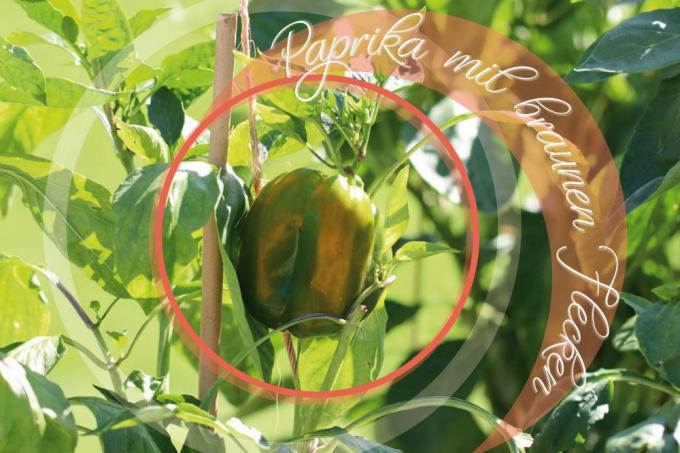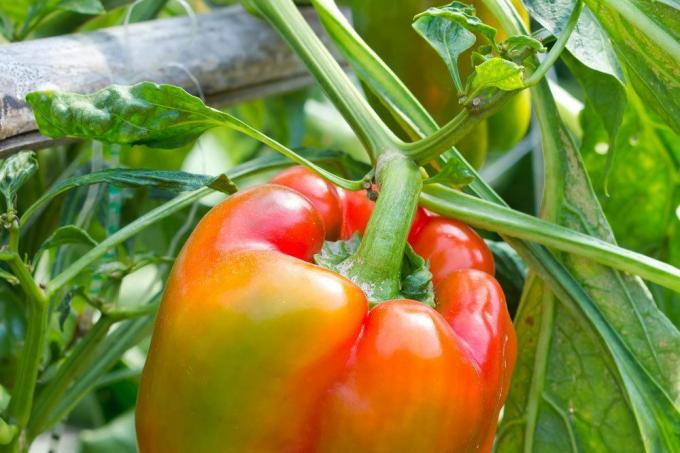
table of contents
- Symptoms
- Flower end rot
- Acute infestation
- Prevent
- Brown rot
- Defense measures
Brown-spotted bell peppers are a real headache for home gardeners. Instead of going through the ripening process with appetizingly shiny skins, the tropical fruits are covered with glassy, brownish necroses before harvest. Stop wondering what to do when peppers are rotting. This guide informs you about the causes of one of the most common types of damage in the cultivation of Capsicum annuum. Tried and tested explanations highlight the correct procedure and give tips for effective prevention.
Symptoms
Characteristic symptoms - an overview
The calamity creeps in, long before the fruits are ripe. The first tissue changes in the form of watery, gray-brown or dark-brown tissue appear at the points of attachment of the flowers Necrosis. As the skin progresses, brown spots appear all over the peel. The rotten spots sink in on different types of paprika and gradually harden. At the same time, it can often be observed that young leaves and flowers grow deformed or that they remain significantly stunted. In the final stage of the dilemma, the peppers fall off after a short period of emergency ripening.
Flower end rot
Cause: flower end rot
If the symptoms described occur in the cultivation of peppers, gardeners are confronted with blossom end rot. This is not a typical one Plant diseasecaused by fungi, viruses or bacteria. Rather, brown spots on ripening peppers result from various deficiency symptoms as a result of neglect of care.

Acute infestation
Act correctly in the event of an acute infestation - this is how it works
If the first symptoms of flower end rot appear, there is an urgent need for action. Are the peppers done once brown necrosis affected, these fruits are lost. To what extent they are suitable for consumption is a matter of controversy among experts. To prevent more peppers from rotting on the shoots, use the following strategy.
- Pick and discard all pods with brown necrosis
- Foliar fertilization with special calcium fertilizers, such as Düngal Calcium, every 8 to 10 days
- Reduce nitrogen fertilization or stop completely for the time being
- Determine the pH value using the soil test set
- Limescale acidic soil with a pH value below 5.5
- Water more regularly from now on and avoid strong fluctuations in the water supply
Lime deficiency in the soil and substrate impairs the transport of important nutrients in leaves, shoots and fruits. If you have previously watered your pepper plants with rainwater, please switch the water supply to normal tap water immediately. You can accelerate the regeneration process on peppers in the tub by repotting the plant in fresh substrate.
Prevent
Preventing deficiency symptoms - tips for beds, greenhouses and balconies
Blossom end rot in the cultivation of paprika plants can be relieved if you specifically prevent symptoms of deficiency. The following tips briefly summarize the most important precautions so that peppers do not rot in the bed, greenhouse and balcony.
- in the bed: Rain-protected, sunny location in humus, nutrient-rich soil with a pH value of 6.2 to 7.0
- in the greenhouse: Ventilate daily against excessive humidity, shade in the blazing midday sun
- in the bucket on the balcony: Place under a canopy in a sunny, air-bathed location

The key to successful flower end rot prevention is a prudent one care. Pour the soil in the bed, greenhouse and bucket as soon as the surface dries up. Drought stress also leads to calcium deficiency, as does excessively high humidity or temperatures of more than 25 to 28 degrees Celsius. From a nutrient point of view, nitrogen over-fertilization also causes brown spots and causes peppers to rot within a short period of time. Mineral fertilizers with a concentrated charge of nitrogen have no place in the pepper bed. In contrast, cover organic fertilizerssuch as compost, nettle manure or organic vegetable fertilizer perfectly meet the nutritional requirements. Additional additions of rock flour or algae lime prevent calcium deficiency and keep the pH value in the correct position.
Brown rot
Cause: brown rot as a result of fungal infection
If home gardeners affected can rule out flower end rot as the cause of brown spots, a dreaded one is approaching Fungal infection in focus. Phytophthora spores are the causative agents of late blight and brown rot, which makes growing potatoes and tomatoes a risky undertaking. Since paprika varieties also belong to the nightshade family, the mushrooms do not spare these plants. Rather, with Phytophthora capsici, a subspecies of the fungal genus has formed that has specialized in the infestation of paprika plants.
Clear brown rot infected plants
Fatally, the symptoms are similar to those of flower end rot, making diagnosis difficult for the layperson. As an indication, potatoes are affected first in private cultivation, followed by tomato and pepper plants. If you are already struggling with late blight in the potato bed, the attack can affect yours Bell pepper cultivation cannot be excluded. As a further differentiation criterion in the case of a fungal infection, brown spots in combination with white-gray mold lawn spread in advance on the leaves and shoots before the fruits rot. In the absence of effective control agents for private users, paprika plants infected with brown rot should be cleared and destroyed as soon as possible.
Defense measures
Preventing fungal disease instead of fighting it - tips for natural defense measures
Cunning mushroom spores have bad cards in a sunny, rain-protected location. A balanced water and nutrient balance, as already for the Prevention Recommended against blossom end rot, also keeps brown rot at a distance. In addition to the optimal location and care conditions, you can protect peppers against brown spots with the following measures.
- Give preference to resistant pepper varieties
- Accompany the cultivation with tonics such as liverwort extract or horsetail broth
- Grow each plant with a maximum of three shoots
- avoid any damage to shoots and fruits
- Bell pepper plants are regularly pruned for airy growth
- Mulching root discs with straw to avoid splashing water
- Do not water plants

Small Injuries on peppers cannot always be avoided. Treat small cracks or holes as a result of insect bites promptly to prevent brown ones from forming Necrosis and the pods cannot rot. To do this, let 20 to 30 grams of onion peels soak in 1 liter of boiled water for a few days. When the liquid turns brown, strain off the peels. Brush critical damaged areas with the tincture regularly, pathogenic agents have no access to the plant.



